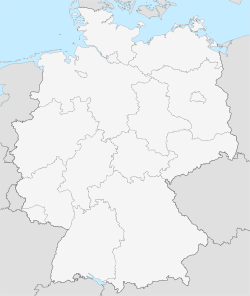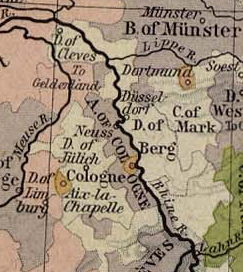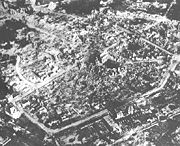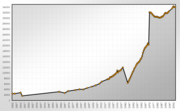Jülich
| Jülich | |
| Coat of arms | Location |
 |
 |
| Administration | |
| Country | Germany |
|---|---|
| State | North Rhine-Westphalia |
| Admin. region | Cologne |
| District | Düren |
| Town subdivisions | 16 |
| Mayor | Heinrich Stommel |
| Basic statistics | |
| Area | 90.4 km² (34.9 sq mi) |
| Elevation | 83 m (272 ft) |
| Population | 33,882 (31/12/2005) |
| - Density | 375 /km² (971 /sq mi) |
| Other information | |
| Time zone | CET/CEST (UTC+1/+2) |
| Licence plate | DN |
| Postal code | 52428 |
| Area code | 02461 |
| Website | www.juelich.de |
Jülich (in old spellings also known as Guelich or Gülich, cf. Dutch: Gulik, cf. French: Juliers) is a town in the district of Düren, in the federal state of North Rhine-Westphalia, Germany. Jülich is well known as location of a world-famous research centre, the Forschungszentrum Jülich and as shortwave transmission site of Deutsche Welle. As a border region between the competing powers in the Lower Rhine and Meuse areas, the town and the Duchy of Jülich played a historic role from the Middle Ages up to the 17th century.
Contents |
Geography
Jülich is situated in the Rur valley on the banks of the river Rur. The town is bordered by the town of Linnich in the north, the municipality of Titz in the north-east, the municipality of Niederzier in the south-east, by the municipality of Inden in the south and the municipality of Aldenhoven in the west. Its maximum size is 13,3 km from east to west and 10,9 km from north to south. The highest point in Jülich is in Bourheim and is 110 m above sea level (except Sophienhöhe, an extensive artificial mountain made up of overburden of a nearby open-pit lignite mine, the Tagebau Hambach), the lowest point is 70 m above sea level and is found in the borough of Barmen.
Boroughs
The town of Jülich comprises 16 boroughs:
- Town centre
- Altenburg
- Barmen
- Bourheim
- Broich
- Daubenrath
- Güsten
- Kirchberg
- Koslar
- Lich-Steinstraß
- Mersch
- Merzenhausen
- Pattern
- Selgersdorf
- Stetternich
- Welldorf (including Serrest)
History


Jülich is first mentioned in Roman times as Juliacum along an important road through the Rur valley. Fortified during the late Roman period, it was taken over by the Franks and grew to be the centre of a county which became the nucleus of a regional power. The counts and dukes of Jülich extended their influence during the Middle Ages and granted Jülich city status in 1234 (Count Wilhelm IV). During battles with the Archbishop of Cologne, Jülich was destroyed in 1239 and again in 1278. In 1416, the city was granted fiscal independence by Duke Rainald of Jülich-Geldern. Following a fire in 1547, the city was rebuilt as an ideal city in the Renaissance style under the direction of the architect Alessandro Pasqualini. The citadel of Jülich was later visited by the French military engineer Sébastien le Prestre de Vauban and was rated exemplary. After the ducal family line was extinguished in 1609, the Duchy of Jülich was divided. The city later belonged to Palatinate-Neuburg, then the Palatinate (1685) and Bavaria (1777).
From 1794 to 1814, Jülich was part of France under the name of Juliers. The French added the Napoleonic bridge head to the fortifications. In 1815, Jülich became a Prussian fortification and district town. The town was subsequently administered within the Prussian Province of Jülich-Cleves-Berg (1815) and then the Rhine Province (1822). The fortification was razed in 1860.

On 16 November 1944 (World War II), 97% of Jülich was destroyed during Allied bombing, since it was considered one of the main obstacles to the occupation of the Rhineland, although the city fortifications, the bridge head and the citadel had long fallen into disuse. The ruined city was subject to heavy fighting for several months until the Allies eventually managed to cross the Rur on 23 February 1945. Jülich became part of the new state of North Rhine-Westphalia after the war. From 1949 to 1956, the town centre was rebuilt along the plans of the Renaissance town.
In 1998, the state garden fair took place in Jülich. This made the extensive restoration of the bridge head fortifications and the establishment of a large leisure park, the bridge head park, possible.
Today, Jülich is mainly known for its world-famous research centre (established in 1956) and the satellite campus of the Fachhochschule Aachen (established in 1970). The town's landmark is the Witchtower, a city gate and remnant of the medieval city fortifications. The most impressive remnants from the past are, however, both the Napoleonic Bridgehead and the Citadel.
Population history

| Population history |
|||||||
| Year | Population | Year | Population | Year | Population | ||
| 300 | 1.500 | 1860 | 3.119 | 12/31 1960 | 14.339 | ||
| 1533 | 1.300 | 1900 | 4.964 | 12/31 1970 | 20.778 | ||
| 1647 | 1.300 | 1920 | 7.688 | 12/31 1980 | 30.433 | ||
| 1735 | 1.520 | 1931 | 10.051 | 12/31 1990 | 31.149 | ||
| 1795 | 2.025 | 1939 | 12.000 | 12/31 2000 | 33.434 | ||
| 1802 | 2.429 | 12/31 1951 | 10.182 | 12/31 2004 | 34.022 | ||
Town twinnings
Since 1964, Jülich is twinned with the French town of Haubourdin in the Nord département.
Transportation
- BAB 4 (Düren / Jülich Interchange)
- BAB 44
- (Jülich Ost (East)/ Mersch Interchange)
- (Jülich West (West)/ Koslar Interchange)
- Rurtalbahn, literally the Rur Valley Railway (Linnich - Jülich - Düren - Heimbach)
Culture and landmarks
Museums
- Historical Town Museum (Website)
Buildings
Particularly notable:
- the Witchtower (Hexenturm)
- the Citadel
- the Napoleonic Bridgehead
- the church of St. Mariä Himmelfahrt
- the Aachener Tor (lit. Aachen Gate)
- aerial towers of shortwave broadcasting facility
Shortwave broadcasting facility
In 1956 the WDR broadcaster established the first short wave transmitter near the borough Mersch. In the subsequent years this site was expanded. On September 1st, 1961 this site was handed over to the German Federal Post for establishing the German foreign broadcasting service, "Deutsche Welle". In the course of time 10 transmitters of 100 kilowatts were installed, whereby as transmitting antennas enormous dipole arrays between free standing steel framework towers were installed. Today these transmitters are rented to the predominant part to non-German broadcasting organisations. In the 90's on the area of the shortwave transmission facility also a transmitting plant for medium wave was installed, using a long wire antenna which is spun at a tower on the transmitter site. It was intended to be used for transmission of the programme of radio Viva on 702 kHz, but it never went into regular service for this broadcaster. Since December 6, 2004, the mediumwave transmitter is used to broadcast the programme of the German commercial broadcaster "TruckRadio" on 702 kHz.
Miscellaneous
The reliquaries of Christina von Stommeln.
Sports
The most successful and well-known Jülich-based sports teams are TTC Jülich (table tennis, which competes in the Bundesliga, the domestic premiere league) and the SC Jülich 1910, an amateur football (soccer) club that won the German national amateur championships in 1969, 1970 and 1971.
People
- Alessandro Pasqualini
- Bobby Julich - American Cycling Star has traced his family ancestry back to Jülich.
- The Gulick's of America all trace their ancestry through Hendrick Gulick (aka Van Gulick) Born: 1625 in Julich (Duchy of Jülich) , North Rhine-Westphalia, Germany. He Married: 1646 in Amsterdam, Netherlands and Died: 1653 at Gravesend, Brooklyn, Kings County, New York.
- In the Netherlands, the name Van Gulik is quite common, e.g. the much translated author Robert van Gulik. But one also finds variants like: Van Gulick, Van de(r) Gulik (cf David Van Der Gulik), Guliks, Gulickx, Gulikers, and Jülicher.
Famous citizens
- Johann Wilhelm Schirmer (1807 - 1863)
- Antonius Fischer
- Siegfried J. Schmidt now (1940-)
- Joseph Kuhl
- Peter Grünberg now (1939-)
Literature
This page is mostly a translation of the article in the German language Wikipedia.
- Guido von Büren (Hrsg.): Jülich Stadt - Territorium - Geschichte, Kleve 2000, ISBN 3933969107
- Ulrich Coenen: Von Juliacum bis Jülich. Die Baugeschichte der Stadt und ihrer Vororte von der Antike bis zu Gegenwart, 2. Aufl., Aachen 1989. ISBN 3-925714-17-0
- Ulrich Coenen: Stadt Jülich = Rheinische Kunststätten, Heft 368, Neuss 1991. ISBN 3-88094-696-5
- Conrad Doose/Siegfried Peters: Renaissancefestung Jülich, 1998, ISBN 3-87227-058-3
- Ulrich Eckardt/Wolfgang Hommel/Werner Katscher: Flug über Jülich, 2003, ISBN 3-87227-076-1
- Wolfgang Hommel: Stadtführer Jülich, 1998, ISBN 3-87227-065-6
- Wolfgang Hommel: Jülich im Aufbruch - Landesgartenschau und Stadtentwicklungsprogramm Jülich '98, 1998, ISBN 3-87227-098-2
- Dr. Erwin Fuchs/Wolfgang Hommel: Die Jülicher und ihre Wurzeln, 1997, ISBN 3-87227-063-X
- Eva Behrens-Hommel: Sagen und Überlieferungen des Jülicher Landes, 1996, ISBN 3-87227-061-3
- Eva Behrens-Hommel: Mundartsammlung des Jülicher Landes, 1997, ISBN 3-87227-062-1
- Hartwig Neumann: Stadt und Festung Jülich auf bildlichen Darstellungen, Bonn 1991. ISBN 3-7637-5863-1
- Gabriele Spelthahn: An der Synagoge - Jülich und der Holocaust, 1997, ISBN 3-930808-08-0
External links
- http://www.juelich.de/
- http://www.fz-juelich.de/ - The research centre
- http://www.fh-aachen.de/abt_juelich.html - University of applied sciences Aachen/Jülich
- http://www.kuba-juelich.de/ - The culture and leisure centre
- http://www.brueckenkopf-park.de/ - The former state garden fair
- http://www.juelich.de/www-juelich/ - The web directory of Jülich
- http://www.juelich-webcam.de Nice Webcam with a view of the witch tower
- Edicts of Jülich, Cleves, Berg, Grand Duchy Berg, 1475-1815 (Coll. Scotti) online
- Settlement of Dortmund between Brandenburg and Palatinate-Neuburg and the conflict of succession in Jülich, in full text
|
|||||||